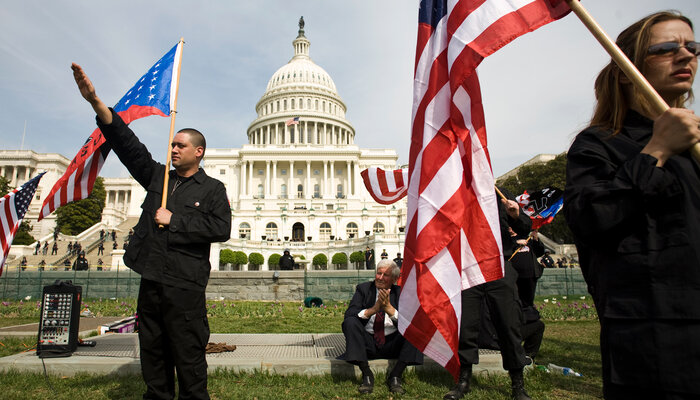
How to Combat White Supremacist Violence? Avoid Flawed Post-9/11 Counterterrorism Tactics
Attempts to expand government powers and to predict violence based on beliefs remain ineffective.

Part of
On January 6, a mob including white supremacists and far-right militants stormed into the Capitol as lawmakers were certifying Joe Biden’s election victory. The attack followed mass shootings by white supremacists — like in El Paso in 2019 and a Pittsburgh synagogue the year before — and relatively unpoliced public violence by far-right militants at rallies across the country since Donald Trump’s election.
The Biden administration now seeks to turn the post-9/11 counterterrorism enterprise’s attention toward suppressing terrorism perpetrated by “domestic violent extremists.” But in making this shift, it is vital that we learn from the mistakes of our post-9/11 response rather than simply repeating them. Already there are signs that we are falling prey to the same problematic assumptions that took hold 20 years ago — namely, that we need to expand counterterrorism authorities and use ideology as an indicator of potential violence.
These approaches are sure to backfire. Instead, our government should direct its focus toward pursuing and punishing acts of violence that it has too long ignored, using the ample tools at its disposal and without regard to ideology.
The red herring of new authorities
Following the 9/11 attacks, Congress raced to provide the government with new authorities to go after international terrorist groups. Within weeks of the attacks, Congress passed the Patriot Act. The law vastly expanded the government’s ability to secretly collect Americans’ personal information and communications data without probable-cause warrants or suspicion of wrongdoing, despite the absence of any analysis suggesting that this increased surveillance was necessary to effectively prevent terrorism.
Later examinations showed these authorities were easily abused to infringe on Americans’ privacy rights. The one program that was subject to extensive independent review was found to be all but useless in identifying terrorist plots — not to mention illegal.
Nonetheless, there have been similar calls to expand the government’s authorities in the wake of the January 6 attack. The White House is now seriously considering proposals to give law enforcement new statutory authority to take on domestic terrorism. But white supremacist and far-right militant violence is not a new problem, and the FBI has significant legal authority to tackle it — as the multitude of federal charges against more than 500 people who attacked the Capitol attest.
Indeed, an entire chapter of the U.S. criminal code is devoted to terrorism. It contains 57 federal crimes of terrorism, 51 of which apply to domestic acts. Federal prosecutors use these and dozens of other applicable federal statutes in charging twice as many domestic terrorism cases than international terrorism cases in recent years (using just a fraction of the resources). Federal prosecutors have made clear that some of those who participated in violence during the attack on the Capitol have been charged with “crimes of terrorism.”
The FBI’s inadequate response to far-right violence results from a lack of will, not a lack of legal authority. The FBI has used its domestic terrorism authorities aggressively to target and harass environmentalists and animal rights activists, despite the fact that these groups have not committed a single fatal attack. Yet the FBI doesn’t even track the number of murders committed by white supremacists each year, much less consistently investigate these crimes as domestic terrorism.
Expanding counterterrorism authorities will not solve this attention deficit. To the contrary, both history and recent events suggest that new laws could become tools in the future for FBI agents to target those seeking to reform systems of structural racism and social inequity rather than those committing racist violence. Indeed, Trump and Attorney General William Barr labeled anti-racism and police violence protesters as domestic terrorists and diverted counterterrorism resources away from investigations of violent white supremacists and far-right militants who later attacked the Capitol.
A misdirected focus on ideology
The Biden administration has also revived an Obama-era program designed to counter “violent extremism,” which relied on widely discredited theories of terrorist radicalization that painted Muslim religious practices and the expression of political grievances as precursors to violence.
Moving the counterterrorism focus from investigating deadly violence that fits the statutory definition of domestic terrorism to suppressing “extremist” ideologies is dangerous, as it implies that law enforcement should play a role in determining what ideas Americans are permitted to express. If there’s anything we’ve learned from the “war on terror,” it’s that stretching law enforcement beyond its appropriate focus on crime and violence can undermine the very democratic values white supremacy opposes.
The Biden administration has rebranded the Obama administration’s program, which was framed as “countering violent extremism” or CVE, as the Department of Homeland Security’s Center for Prevention Programs and Partnerships (CP3). Like CVE, the CP3 program seeks to train law enforcement officials, educators, public health officials, social workers, and private citizens to identify and report people who show purported warning signs that they might commit an act of “targeted” violence or terrorism sometime in the future. These supposed indicators include some combination of vague and commonplace characteristics like holding a grievance, being socially alienated, and feeling hopeless. In some cases, individuals with these traits might need some kind of assistance, but treating them as would-be mass murderers is misguided.
In addition to falsely labeling people in need as dangerous, this flawed approach corrodes the trust that teachers, coaches, religious leaders, therapists, and others need to serve as mentors, provide treatment, or otherwise help people work through difficult times in their lives. It also opens a pipeline for channeling well-documented societal biases into an already corrupted “pre-crime” law enforcement surveillance system.
As for law enforcement agents, directing them to counter “radical” ideologies or identify ill-defined “concerning behaviors” will undoubtedly lead to the targeting of those who challenge the status quo — immigrant communities, communities of color, religious minorities, and activists — rather than white supremacists who have long been deeply embedded in powerful government institutions like law enforcement and the military, as the Capitol riot demonstrated. History provides ample evidence of this point: ideas that have stood in opposition to established structures of power, such as civil rights, labor organizing, or women’s suffrage, are the ones law enforcement has treated as “radical.”
A better way forward
Instead of using dubious methods to predict the next mass shooter, law enforcement should address deadly violence that is already occurring. Police and prosecutors have turned a blind eye to violence at far-right rallies around the country where counter-protestors were shot and beaten, including by some perpetrators who later stormed the Capitol. According to media reporting, three far-right militants who tried to break into the Oregon State Capitol the month before also participated in the Capitol riots, yet remain uncharged. More broadly, despite an annual expenditure of more than $100 billion on policing in the U.S., more than half of violent crime goes unsolved each year, including almost 40 percent of murders and more than 65 percent of rapes, with racial minorities disproportionately feeling the impact of this law enforcement inaction.
Until recently, the Department of Justice has failed to prioritize the investigation and prosecution of white supremacist violence — treating it as a lesser threat than so-called “eco-terrorism,” which has cost zero American lives. Shortly before the attack on the Capitol by a mob that included active members of law enforcement, FBI managers disavowed a 2006 bureau intelligence assessment warning of white supremacist infiltration of police agencies and refused to participate in a congressional hearing to examine the issue. An FBI intelligence report issued after the Capitol attack substantiated the findings of the 2006 assessment.
The government’s misplaced priorities are reflected in — and enabled by — its failure to accurately and comprehensively track white supremacist violence. This failure results from several practices. For one thing, the Justice Department defers investigations of hate crime and most violent crime to state and local police, so many of the violent crimes committed by white supremacists are completely absent from federal databases.
When the Justice Department does investigate white supremacist violence, the investigations fall within several different program categories, including domestic terrorism, civil rights violations, and gang crimes. But the FBI reports assessing the threat from white supremacist violence, count only those crimes it categorized as domestic terrorism, leaving out homicides prosecuted through other programs or deferred to state and local law enforcement. Even within the domestic terrorism program, the FBI puts white supremacists and far-right militant groups into separate categories, even though there is significant overlap between these movements and they often act in concert. Accordingly, the FBI’s data regarding violent attacks and fatalities committed by white supremacists severely underestimates the threat they pose, which in turn results in misallocations of domestic terrorism resources.
Repurposing failed “war on terror” tactics is not the answer to white supremacist and far-right violence. Instead, the Justice Department should use its abundant existing authorities to address violent crime, focusing its resources where they are most needed. Adequately prioritizing white supremacist violence starts with maintaining accurate data about the crimes these groups commit, regardless of how the Justice Department categorizes them. Only with accurate information can policymakers develop effective tactics and hold federal law enforcement accountable for its performance in addressing domestic terrorism.
More from the 9/11 at 20 series
-
Courts Have Been Hiding Behind National Security for Too Long
Racial and religious minorities have suffered from judicial deference to post-9/11 claims of national security. -
Reining in the President’s Sanctions Powers
Used widely since 9/11, the benefits of sanctions often don’t outweigh the full costs. -
Ending the Post-9/11 Forever Wars
Congress wrongly gave the president carte blanche to use military force, and we’re still paying the price.





